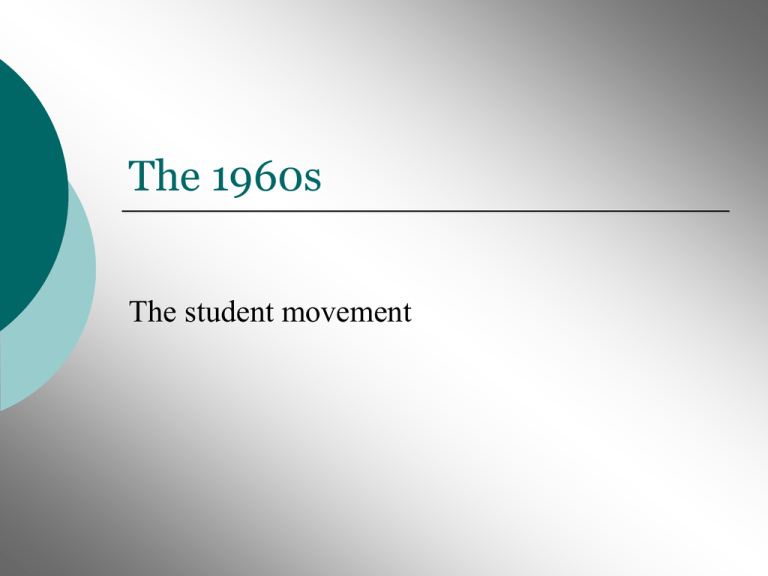
The 1960s
The student movement
Roots of student activism
Many of the first students involved were
inspired by the CRM.
Reacting against what they saw as artificial,
materialistic, conformist, and non-democratic
society.
Everyone should do meaningful work and be
well-paid.
Philosophical roots
Like the CRM, most students believed in
nonviolence.
In the NE, many were children of radical
(socialist, communist, or social democratic)
parents.
Outside the NE, many were inspired by
Christian existentialism: they were morally
required to improve earthly conditions for all.
Political beliefs
Liberalism held that structure of American
society fine, just needed periodic reform.
Old left: radical change would come through
organized labor.
“New left:” radical change would come
through students and poor. Those left out of
system could create new structures.
Role of universities
Universities ideal site for organizing
Should be places of learning as well as
implementing new ideas
Should be places where students could find
the authentic
Students could engage in participatory
democracy on campus
Students for a Democratic Society (SDS)
Formed in 1960
Many members active with SNCC
In 1962, the group drafted the “Port Huron
Statement”
In 1963, began Economic Research Action
Project (ERAP) in ten major cities.
Soon turned focus to Vietnam.
War in Vietnam
U.S., with huge
military might, invaded
tiny country but lost.
7,000,000 tons of
bombs dropped
Almost one 500 pound
bomb for each person
in Vietnam.
Why was the U.S. involved?
French colony until the French were defeated
in 1954
Geneva Accords divided country into North
and South—communist North.
U.S. installs Ngo Dinh Diem as leader
(dictator)
Democratic elections slated for two years—
never happened
Why was the U.S. involved?
Opposition to Diem regime grew
A few landlords became rich, but peasants
grew poorer
In 1960, National Liberation Front (NLF)
formed. Included many groups, most not
communist
In 1963, Diem assassinated in military coup
(supported by U.S.)
Conflict escalates
Generals could not suppress NLF
In 1964, Gulf of Tonkin.
Allegedly, U.S. ship Maddox attacked
Later, Pentagon Papers suggest that incident
was staged, though many don’t agree
Congressional Tonkin Resolution gives
President power to use force
Bombing (and protest) begins
In 1965, D.C. protest attracts 25,000
By 1968, 500,000 American troops on the
ground
War polarizes the nation—takes down LBJ
In 1968, Nixon proposes “vietnamization”
Horrors of war
My Lai massacre—68
Over 500 civilians
intentionally killed
In 1969, the story broke
in the NYT
William Calley, the Unit
leader, convicted
Nixon commuted
sentence
The war ends
Some veterans return with horror stories
In 1967, Vietnam Veterans against the War starts with 3
protesting vets—membership grew quickly
In 1973, the U.S. withdraws
In 1975, N. Vietnamese defeat Saigon, became
Democratic Republic of Vietnam
Casualties: 58,178 American; millions of Vietnamese,
Laotians, and Cambodians
The nature of the opposition
U.S. wrong to interfere
with other countries
When Vietnam
defeated France, should
have had immediate
elections
Right to selfdetermination
The nature of the opposition
View of communism to
simplistic
USSR and China not
involved in plot to take
over world—were in
fact enemies
Domino theory wrong
The nature of the opposition
As the war grew, critique broadened
Movement became more anti-imperialistic
By 1969, 60% of Americans disapproved of
the war, but many didn’t like protesters,
finding them unruly and disruptive
The Counterculture: sex, drugs, and
rock ‘n roll
1960—introduction of birth control pill,
though not legal in every state
Pill allowed women more sexual freedom
Such freedom—the sexual revolution—
horrified many
Rock ‘n roll
Revival of folk music and protest songs—
move away from bubblegum pop of the 50s
Bands with large followings like the Beatles
as opposed to one-hit wonders
Psychedelic music—The Grateful Dead—
very tied in with drug culture
Hippies
LSD—developed by Timothy Leary of
Harvard
Marijuana also very popular
“Tune in, turn on, drop out”
Many political activists put off by hippies,
but “middle America” thought their children
had gone crazy
Hippie chic
Long hair for men and
women
Clothing became part of
self-expression
Loose, “ethnic” styles
Hand made, embellished
items
Sexual, colorful,
nonconformist
Hippie philosophy
Live communally—share what you have
Reject materialism
Follow your heart
Express yourself through music and art
Love and peace most important


